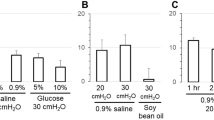Abstract
Proteolytic enzyme inhibitors were examined as absorption enhancers for the nasal delivery of vasopressin (AVP) and desmopressin (l-d-8-DAVP) in rats. Aprotinin, soybean trypsin inhibitor, and camostat mesilate were used as enzyme inhibitors. The nasal absorption of AVP and l-d-8-DAVP was evaluated by measuring its antidiuretic effect. Nasal administration of AVP (0.005 IU/kg) or l-d-8-DAVP alone (2.5 ng/kg) produced a small antidiuretic effect. Coadministration with aprotinin (1000 and 10000 KIU/kg) or soybean trypsin inhibitor (1.25 and 6.25 mM) did not change the antidiuretic effect. However, coadministration with camostat mesilate (1 to 50 mM) significantly increased the antidiuretic effect and, thus, the nasal absorption of AVP and l-d-8-DAVP. The activities of aminopeptidase, cathepsin-B, and trypsin in the nasal mucosal tissue of rats were 7 nmol/min/mg protein, 0.7 nmol/min/mg protein, and 4.6 pmol/min/mg protein, respectively. Aprotinin and soybean trypsin inhibitor inhibited only the trypsin activity, whereas camostat mesilate inhibited aminopeptidase and trypsin activities. Aprotinin (MW 6500) and soybean trypsin inhibitor (MW 8000), with relatively high molecular weights, may not permeate into the nasal mucosal tissue. In contrast, camostat mesilate is slowly absorbed (8%/hr) and could inhibit the proteolytic activity in the nasal mucosa, resulting in enhanced nasal absoprtion of AVP and l-d-8-DAVP.
Similar content being viewed by others
REFERENCES
Y. W. Chien, K. S. E. Su, and S. F. Chang (eds.). Nasal Systemic Drug Delivery, Marcel Dekker, New York, 1989, pp. 1–26.
C. McMartin, L. E. F. Hutchinson, R. Hyde, and D. E. Peters. Analysis of structural requirements for the absorption of drugs and macromolecule from the nasal cavity. J. Pharm. Sci. 76:535–540 (1987).
V. H. L. Lee. Enzymatic barriers to peptide and protein absorption and use of penetration enhancer to modify absorption. In S. S. Davis, L. Ilium, and E. Tomlinson (eds.), Delivery Systems for Peptides Drugs, Plenum Press, New York, 1986, pp. 87–104.
I. Vavara, A. Machova, and I. Krejci. Antidiuretic action of l-deamino-8-D-arginine-vasopressin in unanesthetized rats. J. Pharmacol. Exp. Ther. 188:241–247 (1987).
J. M. M. van Bree, S. Tio, A. G. de Boer, M. Danhof, J. C. Verhoef, and D. D. Breimer. Transport of desglycinamide-arginine vasopressin across the blood-brain barrier in rats as evaluated by the unit impulse response methodology. Pharm. Res. 7:293–298 (1990).
K. Morimoto, H. Yamaguchi, Y. Iwakura, K. Morisaka, Y. Ohashi, and Y. Nakai. Effects of viscous hyaluronate-sodium solution on the nasal absorption of vasopressin and an analogue. Pharm. Res. 8:471–474 (1991).
S. Koyama, M. Sasaki, T. Setoyama, K. Takahashi, K. Togashi, K. Suzuki, N. Nakai, and M. Imai. Dopaminergic modulation of the renal effect of arginine-vasopressin in waterloaded rats. Jpn. J. Pharmacol. 38:25–30 (1985).
S. Hirai, T. Yashiki, T. Matsuzawa, and H. Mima. Absorption of drugs from the nasal mucosa of rat. Int. J. Pharm. 7:317–325 (1981).
Y. Ohashi and Y. Nakai. Reduced ciliary action in chronic sinusitis. Acta Otolaryngol. Suppl. 397:3–9 (1983).
F. Komada, K. Okumura, and R. Hori. Fate of porcine and human insulin at the subcutaneous injection site. II. In vitro degradation of insulins in the subcutaneous tissue of the rat. J. Pharmacobio-Dyn. 8:33–40 (1985).
K. Morimoto, T. Iwamoto, and K. Morisaka. Possible mechanism for the enhancement of rectal absorption of hydrophilic drugs and polypeptides by aqueous polyacrylic acid gel. J. Pharmacobio-Dyn. 10:85–91 (1987).
K. Yamaoka, Y. Tanigawara, T. Nakagawa, and T. Uno. A pharmacokinetic analysis program (MULTI) for microcomputer. J. Pharmacobio-Dyn. 4:879–885 (1985).
M. A. Hussain, A. B. Shenvi, and S. M. Rowe, and E. Shefter. The use of α-aminoboronic acid derivatives to stabilize peptide drugs during their intranasal absorption. Pharm. Res. 6:186–189 (1989).
M. Saffran, C. Bedra, G. S. Kumar, and D. C. Nackers. Vasopressin: A model for the study of effects of additives on the oral and rectal administration of peptide drugs. J. Pharm. Sci. 77:33–38 (1988).
T. Owaki, H. Ando, F. Kakimoto, K. Uesugi, S. Watanabe, Y. Miyake, and M. Kayano. Effects of dose, pH and osmolarity on nasal absorption of secretion in rats. II. Histological aspects of the nasal mucosa in relation to the absorption variation due to the effects of pH and osmolarity. J. Pharm. Sci. 76:695–698 (1987).
W. A. J. J. Hermans and F. W. H. Merkus. The influence of drugs on nasal ciliary movement. Pharm. Res. 4:445–449 (1987).
W. A. J. J. Hermans, P. M. Hooymans, C. Verhoef, and F. W. H. Merkus. Effects of absorption enhancers on the human nasal tissue ciliary movement in vitro. Pharm. Res. 7:144–146 (1990).
Author information
Authors and Affiliations
Rights and permissions
About this article
Cite this article
Morimoto, K., Yamaguchi, H., Iwakura, Y. et al. Effects of Proteolytic Enzyme Inhibitors on the Nasal Absorption of Vasopressin and an Analogue. Pharm Res 8, 1175–1179 (1991). https://doi.org/10.1023/A:1015862603939
Issue Date:
DOI: https://doi.org/10.1023/A:1015862603939



